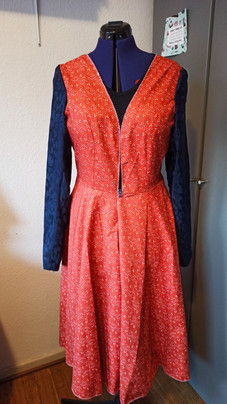Princess Raincoat - Charm Patterns
- JuMa

- 2. Nov. 2020
- 4 Min. Lesezeit
This project was the most complicated and time consuming one and where I learned the most in 2020 but I made myself a raincoat!
However, let us start at the beginning:
During the pandemic, I started working as a part-time saleswoman in the local fabric store Stoff Magie to keep myself busy and earn some money while I completed my master's degree online and looked for a full-time job.
One day, I think it was in June, a woman in a beautiful vintage-style raincoat made of a bright yellow fabric visited our shop and bought some fabric. Her raincoat was gorgeous and while we chatted a little, I asked her if she'd sewn it herself and what pattern she'd used. She said yes, she'd made it using the Princess Coat pattern from Charm Patterns. I was quite impressed as it looked really complex and professional, but I thought I should also try that pattern myself.
But, like I said, it was summer and I had other projects I wanted to tackle. So I kind of forgot about the raincoat until I got a newsletter from stoffe.de advising various waterproof fabrics. One of them was a beautiful navy one with small shiny dots - and suddenly
I wanted to sew a raincoat to have an excuse to buy this beautiful fabric!

So now you know why I wanted to sew a raincoat.
But it took me some time to start the process after I bought both the fabric and the pattern. That was mainly for the reason that I wanted the fit to be perfect. That's why I first wanted to sew a sample of the coat bodice - but I first had to pull myself together for this. Normally, I directly start sewing with the fabric I chose and make the adjustments during the sewing.
However, as it was also the first time me using a pattern by Charm Patterns, I made a muslin to check the construction and the fit of the pattern. It turned out to be quite a good idea as I also adjusted some other parts of the pattern. Because I wanted to sew a raincoat and there is no hood included in the original pattern, I decided to draft one myself.
Before that I had already decided to sew a different closure method and not the bound buttonholes (which closure I wanted to decide only after the coat was finished). So, I "only" made a muslin with the front and back pieces of the bodice, the arms and the self-drafted hood out of leftover cotton fabric from my stash.
I sewed a straight size 12 and the fit was great except for a little too short sleeve. Therefore, I decided to lengthen the sleeve pattern by 5 cm and then just give it a go. For the lining I found a beautiful terracotta coloured cotton fabric with small prints in the local fabric shop where I work and for the sleeve lining, I chose a navy viscose jacquard.
Cutting and sewing the waterproof fabric wasn't as complicated as I thought but it was definitely kind of nerve-racking. I was afraid of making even a small mistake and leaving holes in my beautiful fabric which could not be repaired. Therefore, I took my time with the whole sewing process. And I really had to take my time, as I ironed seam sealing tape onto every seam of my waterproof fabric - a very lengthy process which consumed about 20m of seam sealing tape in total!
Sewing the coat lining was kind of simple after sewing the outer fabric. The process seemed
to be the same and the fabric was easier to handle. I also made the decision to sew in an inside pocket.
Unfortunately, I found out afterwards that I forgot to sew a slip into the lining between the top and the hood. This caused a few challenges when joining the lining to the outer fabric. But with the help of one of my colleagues, who is a trained seamstress, and by using fabric stays as a connection between the lining and the outer fabric, I joined both layers together and secured the lining in several places.
The last, most exciting, and most instructive steps were sewing the sleeve hems, the coat hem and the closure.
To make sure that the lining and the outer fabric of the sleeves will not twist is always a mental challenge for me. Sewing the coat hem together properly and then closing the last bit by hand was definitely exciting. I also had to work with hem tape for the first time to get a nice round coat seam. In these steps I got the most support from my colleague and asked the most questions.
For the closure I chose press buttons so that the smooth front of the coat is not destroyed by buttonholes. This last work by hand was both exciting and stressful. I was afraid to ruin the coat at the last moment and at the same time I could hardly wait until it was finally finished.

But now it is finished and I'm just super proud of myself!
The fit is perfect and even if there are little things I could have done better, I am super happy with the result. It is not my first self-made coat, but it is my first raincoat and certainly a piece of my wardrobe that will be loved very much. I am totally crazy about the vintage style of the pattern and feel completely comfortable when I wear the coat.
Even though it was a costly and labour-intensive project, it was clearly worth it!I have already taken pictures that hopefully reflect my appreciation.
So please check out the pictures and detail shots of my beautiful Princess Raincoat (there are also some funny action shots :D)
Summary:
Pattern:
- Princess Coat by Charm Patterns; Size 12
Fabric:
- navy waterproof fabric by stoffe.de
- terracotta cotton fabric and navy viscose jacquard from Stoff-Magie
Adjustments:
- self-drafted hood
- lengthened sleeves by 5 cm
- extended the inseam pockets
- added an inside pocket
- chose press buttons for closure
Time invested: Several hours spread over four weeks
Money invested: About 180€ in total
All in all, absolutely worth it!


























































































Kommentare